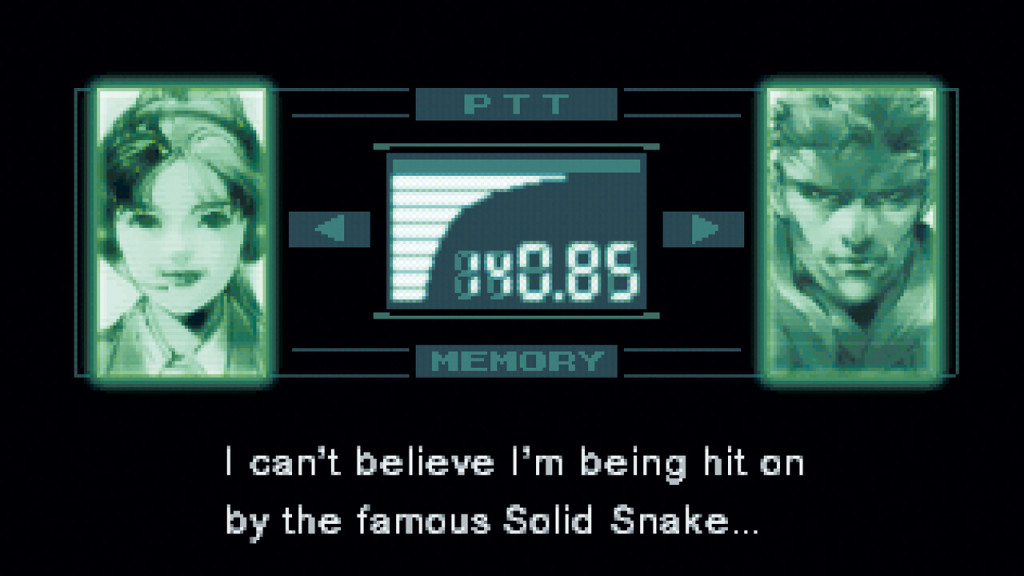Last updated on August 7, 2014
Please Read Part 1 Before Proceeding! Also, Spoilers!
Excepting the above tower climb, most sequences without stealth (thankfully) work less like “pop headshots” (Splinter Cell) and more “figure out the correct sequence of events to solve this puzzle”. The Nikita Missile puzzle before Grey Fox, for example, emphasizes such a focus, with multitasking of air and a homing missile that will crash into walls without proper control. I would not think it an overstatement to say that we could call Metal Gear Solid a series of puzzle rooms with plot for context and immersive intensity. Each boss fight requires a puzzle approach too, in that they require particular items and techniques to succeed. There’s a general pattern and solution, of course, but there’s enough variation to make each one interesting in and of itself.
In fact, the game more often than not requires completely out-of-the-box thinking.

The solutions to some of these puzzles immediately break the fourth wall, requiring physical effort on your part or even looking for information on a CD case. The torture sequence supposedly can be done without a turbo controller, but the game says that it will know. Instead, I used an arcade stick with wonderful, tappable buttons to ensure I didn’t die (since there’s no Continue if you die here). I love the sort of feeling that gives my brain; figuring the solution yourself always works much better than letting the game solve it for you. These sorts of strange strategies as a necessity diminish as the game reaches its gigantic action-movie climax, but that doesn’t make the game any less enjoyable. That comes through in the story as well!
As the unavoidable one thousand ton Metal Gear in the room, you pretty much NEED to talk about the story in order to understand Metal Gear Solid’s appeal. Told in a now-trademark Kojima style, it combining political, social, scientific, and psychological topics that integrate real world problems with a possible fantasy/science fiction side. Many wonder whether it’s intentionally crazy, and I assure you it’s not. It seems clear to me that psychic forces and shamans do add something to the flavor of Metal Gear Solid in that they often represent technology sufficiently advanced to the point where it looks like magic. That comes out in fuller force later in the series, but that theme looks rather clear even here.
Much of its effectiveness comes through the admittedly dated cutscenes. Unlike most of its ilk at the time, Kojima took a risk by implementing all cutscenes in-game, a revolution at the time that we still see today. Even the early showing of motionless bobbing heads works effectively enough to convey the emotions of a scene, and Metal Gear Solid’s cinematography still holds up today. I can’t quite tell you why it works (probably because a lot of the techniques blatantly steal from cinema), but I still saw and felt the emotions of the moment. And yes, sometimes boss fights are followed by interminable cutscenes when I REALLY NEED TO PEE, but that doesn’t mean they aren’t interesting, You could only do this sort of exposition with the limited technology available, and while it seems semi-absurd as the series progresses, it possesses a charm here.

In the same way, codec calls take forever, but work precisely due to their technical limitations. Obviously, to tell the whole story via in-game cutscenes would take forever and go massively overbudget, so lots of voice acting and text boxes fill in the blanks. Clearly, the Playstation hampers the possibilities of any narrative working in a truly cinematic style, so Kojima fills in the details with codec calls…because he can, that’s why. A movie does not let you delve into backstories, sidestories, and character arcs, nor fill the world at least in impression. Codecs allow Kojima to form the illusion of a larger world beyond Shadow Moses and the central plot, and it works brilliantly.
Even without an editor (Kojima remains one of the only unfiltered auteurs out there…but he definitely needs an editor sometimes!), you can see a wide variety of influences and important subject matter. Most of them contain a strange combination of plot exposition, character dramatics, recalls to previous games, quotes from famous literary figures or philosophers, real-world science/psychological data, and even musings on life, war, and human emotion. They are, for lack of better words, entertaining and insightful, even when they sometimes become redundant.
Or, at the very least, they give you the impression of real people living in a real world all sacrificing something for the sake of a mission. In all the times I saved the game (36, according to the end-game record screen), Mei Ling never threw the same quote at my twice; that’s quite a feat, and that depth of dialogue fosters the illusion of reality that all great stories can. That level of detail gets you wrapped up in the tale’s twists and turns, even if all the details don’t fully line up. There’s enough dialogue that you learn about all the characters and experience some actual emotional moments, should you find yourself immersed enough.
What Metal Gear Solid does best, though, completely immerses you: the constant fourth wall breaks which point to a predominantly postmodern perspective. Metal Gear Solid is one of the first games to really recognize that the player playing the game has as much a role as the people onscreen. Furthermore, it’s incredible self-aware that it’s a stupid and somewhat silly spy/action movie…but it’s not, it’s a video game! Often, conversations and direct conversatons on codec or cutscenes intentionally blur the line between the player and Solid Snake. Sometimes they refer to you as a soldier, and sometimes they refer to YOU as a gamer, and it honestly creeps me out. Why does the game do this? Well, we could say it allows them to give tutorials without breaking the immersion, but they CONTINUE to do this even after all relevant information emerges.
It’s creepy!
